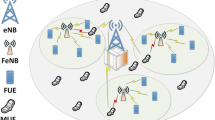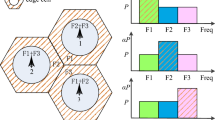Abstract
Multi-tier heterogeneous network (MHN) has recently emerged as a main technology in 5G network. Dense deployment of heterogeneous nodes in 5G MHN will have more density than single-tier networks. In 5G MHN, by increasing the number of small cells, network capacity, spectral efficiency, and data rate will increase. But reducing the dimension of the cell will cause inter/intra-tier interference in both uplink and downlink channels of MHN. High transmit power of Macro Base Station (MBS) downlink channel causes interference to Small cell User Equipment (SUE). Also, neighbor macrocell and small cell users suffer from interference created in both uplink and downlink channels of small cell. Thus interference management and mitigation is the important challenge for 5G MHN. In this paper, in order to mitigate both types of inter/intra-tier interferences, spectrum trading issue and power control are presented based on non-cooperative Stackelberg game under some sub-games through a pricing-based algorithm and convex optimization method. Finally, simulation results show that the performance of our system model such as average utility function of the small cell, SBS, energy efficiency and so on, will be improved through the proposed algorithm.










Similar content being viewed by others
Notes
Attached-user is a user which is connected to the small cell and is located in Range Extension (RE).
SBSs which are allowed to transmit data to SUE.
SBSs which are not allowed to transmit data to SUE.
Generally, energy efficiency is defined as a ratio of transmit rate to sum transmit and circuit power that is considered circuit power is zero.
References
Ma, Z., Zhang, Z., Ding, Z., Fan, P., & Li, H. (2015). Key techniques for 5G wireless communication: Network architecture, physical layer, MAC layer perspectives. Science China Information Sciences, 58(4), 1–20.
Hossein, E., & Hasan, M. (2015). 5G cellular: Key enabling technologies and research challenges. IEEE Instrumentation and Measurement Magazine, 18(3), 11–21.
Andrews, J., Buzzi, S., Choi, W., Hanly, S., Lozano, A., Soong, A., et al. (2014). What will 5G be? IEEE Journal on Selection Areas in Communication, 32(6), 1065–1082.
Muirhead, D., Imran, M. A., & Arshad, K. (2016). A survey of the challenges, opportunities and use of multiple antennas in current and future 5G small cell base stations. IEEE Access, 4, 2952–2964.
Han, R., Feng, C., Xia, H., & Zhang, T. (2014). On the fairness of range expansion with interference mitigation in heterogenous networks. IEEE Communications Letter, 18(6), 1051–1054.
Zhou, X., Feng, S., Han, Z., & Liu, Y. (2015). Distributed user association and interference coordination in HetNet using Stackelberg game. In IEEE International Conference on Communication (ICC). https://doi.org/10.1109/ICC2015.7249349.
Wu, Y., Xia, H., Lu, Y., Feng, C., Zhang, T., Han, R., et al. (2014). Clustering-based time-domain inter-cell interference coordination in dense small cell network. In IEEE 25th Annual International Symposium on Personal, Indoor, and Mobile Radio Communication (PIMRC). https://doi.org/10.1109/PIMRC.2014.7136230.
Chen, L., Xia, H., Feng, C., & Xu, S. (2015). Clustering-based co-tier interference coordination in dense small cell networks. In IEEE 26th Annual International Symposium on Personal, Indoor, and Mobile Radio Communications (PIMRC). https://doi.org/10.1109/PIMRC.2015.7343605.
Ahmed, M., Peng, M., Zhang, B., & Ahmad, I. (2014). A distributed coalition formation scheme for interference management in dense small cell networks. In The 5th International Conference on Game Theory for Networks (GAMENETS). https://doi.org/10.1109/GAMENETS.2014.7043690.
Al-Gumaei, Y.A. , Noordin, K.A., Reza, A.W., Dimyati, K. (2015). A new power control game in two-tier femtocell networks. In IEEE 1st International Conference on Telematics and Future Generation Networks (TAFGEN). https://doi.org/10.1109/TAFGEN.2015.7289591.
Zheng, J., Cai, Y., & Anpalagan, A. (2015). A stochastice game-theoretic approach for interference mitigation in small cell networks. IEEE Communications Letter, 19(2), 251–254.
Vazquez-Vilar, G., Mosquera, C., & Jayaweera, S. K. (2010). Primary user enters the game: Performance of dynamic spectrum leasing in cognitive radio networks. IEEE Transaction on Wireless Communication, 9(2), 1–5.
Liang, Y. S., Chung, W. H., Ni, G. K., Chen, H., & Kuo, S. Y. (2012). Resource allocation with interference avoidance in OFDMA femtocell networks. IEEE Transactions on Vehicular Technology, 61(5), 2243–2255.
Chandrasekhar, V., Andrew, J., Muharemovic, T., Shen, Z., & Gatherer, A. (2009). Power control in two-tier femtocell networks. IEEE Transaction on Wireless Communication, 8(8), 4316–4328.
Yun, J. H., & Shin, K. G. (2011). Adaptive interference management of ofdma femtocells for co-channe deployment. IEEE Journal on Selected Areas in Communication, 29(6), 1225–1241.
Kang, X., Zhang, R., & Motani, M. (2012). Price-based resource allocation for spectrum-sharing femtocell networks: A Stackelberg game approach. IEEE Journal on Selected Areas in Communications, 30(3), 538–549.
Bennis, M., & Niyato, D. (2010). A Q-learning based approach to interference avoidance in self-organized femtocell networks. In IEEE Globecom Workshop on Femtocell Networks. https://doi.org/10.1109/GLOCOMW.2010.5700414.
Simsek, M., Czylwik, A., Galindo-Serrano, A., & Giupponi, L. (2011). Improved decentralized Q-learning algorithm for interference reduction in LTE-femtocells. Wireless Advanced. https://doi.org/10.1109/WiAd.2011.5983301.
Lopen-Martinez, M., Alcaraz, J., Vales-Alonso, J., & Garcia-Haro, J. (2015). Automated spectrum trading mechanisms: Understanding the big picture. Wireless Networks, 21(2), 685–708.
Li, P., & Zhu, Y. (2012). Price-based power control of femtocell networks: A Stackelberg game approach. In IEEE PIMRC. https://doi.org/10.1109/PIMRC.2012.6362525.
Hamoudo, S., Zitoun, M., & Tabbane, S. (2013). A new spectrum sharing trade in heterogeneous networks. In IEEE Vehicular Technology Conference (VTC Fall). https://doi.org/10.1109/VTCFall.2013.6692046.
Boyd, S., & Vandenberghe, L. (2004). Convex optimization. Cambridge: Cambridge University Press.
Author information
Authors and Affiliations
Corresponding author
Appendix
Appendix
1.1 Appendix(1)
According to Eq. (6), the second derivation of \({U}_{sbs(i)}\) on \({W_{i}}\) is computed:
As the second derivation is less than zero, it is concluded that \({U}_{sbs(i)}\) is a concave function. Therefore \({W_{i}}^{*}\) is obtained by:
According to Eq. (8), the second derivation of \({U}_{mbs}\) on \({\lambda }\) is computed:
As the second derivation is less than zero, it is concluded that \({U}_{mbs}\) is a concave function. Therefore \({\lambda }^{*}\) is obtained by:
1.2 Appendix(2)
1.3 Appendix(2-1)
\({U}_{sbs(i)}\) is a concave function, due to the maximization of concave function is a convex problem so it can be solved by Lagrangian method as:
From (42) it can be written:
From above, \({{P}_{sbs(i)}^{*}}\) can be obtained according to Eq. (19). According to the Lagrangian method, we have:
Therefore, when SBS transmit at \({{P}_{max}^{sbs}}\), interference price will be minimum at this point so:
Then from (19) \({{\mu }}\) can be derived according to (21).
By solving sub-game(2), \({{Price}_{sbs(i)}^{*}}\) is calculated. Therefore, after replacing \({{P}_{sbs(i)}^{*}}\) in (16), sub-game(2) is written as:
But, due to the maximization of convex function is difficult [22], (46) is converted to the minimization problem as:
As problem (47) is a convex optimization, so \({{Price}_{sbs(i)}^{*}}\) can be obtained by the Lagrangian method as:
From (48) it can be written:
From above, \({{Price}_{sbs(i)}^{*}}\) can be obtained as:
Due to, \({{Price}_{sbs(i)}^{*}}\) must be positive, we have:
After replacing \({{Price}_{sbs(i)}^{*}}\) in (51), \({\alpha }\) can be calculated as:
Also, (23) can be obtained by replacing \({{P}_{sbs(i)}^{*}}\) in (53):
1.4 Appendix(2-2)
\({{U}_{sue({{k}_{s}})}}\) is a concave function, due to the maximization of concave function is a convex problem, so it can be solved by the Lagrangian method as:
From above, \({{P}_{sue({{k}_{s}})}^{*}}\) can be obtained according to Eq. (24).
According to the Lagrangian method, we have:
Therefore, when SUE transmit at \({{P}_{max}^{sue}}\), interference price will be minimum at this point:
Then from (24), \({\beta }\) can be driven according to (26). By solving sub-game(3), \({{Price}_{sue({k}_{s})}^{*}}\) is calculated. Therefore, after replacing \({{P}_{sue({k}_{s})}^{*}}\) in (18), sub-game(3) is written as:
But, due to the maximization of convex function is difficult [22], (57) is converted to the minimization problem as:
As problem (58) is a convex optimization, so \({{Price}_{sue({k}_{s})}^{*}}\) can be obtained by the Lagrangian method as:
From (59) it can be written:
From above, \({{Price}_{sue({k}_{s})}^{*}}\) can be obtained according as:
Due to, \({{Price}_{sue({k}_{s})}^{*}}\) must be positive, we have:
After replacing \({{Price}_{sue({k}_{s})}^{*}}\) in (62), \({{\alpha }^{'}}\) can be calculated as:
Also, (28) can be obtained by replacing \({{P}_{sue({k}_{s})}^{*}}\) in (64):
1.5 Appendix(3)
\({{U}_{mbs(n)}}\) is a concave function, due to the maximization of concave function is a convex problem, so it can be solved by the Lagrangian method as:
From (65) it can be written:
From above, \({{P}_{mbs(n)}^{*}}\) can be obtained to Eq. (33).
According to the Lagrangian method, we have:
Therefore, when MBS transmit at \({{P}_{mbs(n)}^{*}}\), interference price will be minimum at this point so:
Then, from (33) \({\nu }\) can be derived according to (35).
By solving sub-game(2), \({{Price}_{mbs(n)}^{*}}\) is calculated. Therefore, after replacing \({{P}_{mbs(n)}^{*}}\) in (31), sub-game(2) is written as:
But, due to the maximization of convex function is difficult [22], (69) is converted to the minimization problem as:
As problem (70) is a convex optimization, so \({{Price}_{mbs(n)}^{*}}\) can be obtained by the Lagrangian method as:
From (71) it can be written as:
From above, \({{Price}_{mbs(n)}^{*}}\) can be obtained as:
Due to, \({{Price}_{mbs(n)}^{*}}\) must be positive, we have:
After replacing \({{Price}_{mbs(n)}^{*}}\) in (74), \({\gamma }\) can be calculated as:
Also, (37) can be obtained by replacing \({{P}_{mbs(n)}^{*}}\) in (76):
Rights and permissions
About this article
Cite this article
Ghorkhmazi Zanjani, G., Shahzadi, A. Game theoretic approach for multi-tier 5G heterogeneous network optimization based on joint power control and spectrum trading. Wireless Netw 26, 1125–1138 (2020). https://doi.org/10.1007/s11276-018-1853-6
Published:
Issue Date:
DOI: https://doi.org/10.1007/s11276-018-1853-6




